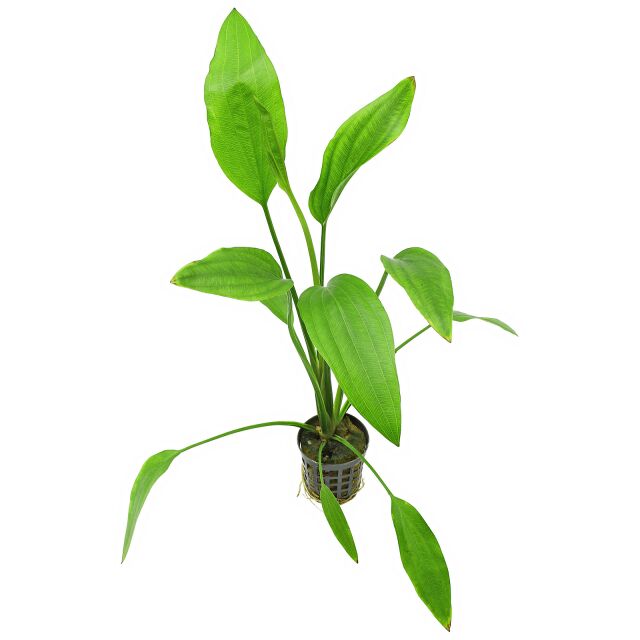


Echinodorus subalatus
- Echinodorus wild type from tropical America
- Rather rarely available
- Large solitary or group plant
- Green, lanceolate leaves
- Also recommendable for paludaria
Sign in or Register
Item question
We’re here for you!
Please enter your question and e-mail and we’ll contact you as soon as possible. It usually takes us up to 24 hours during business days to respond.
Thank you for your question!
Thank you, we’ll get in touch!
Close window
You already sent us a question.
Please wait a few minutes
Description
Echinodorus subalatus is widespread in the wetlands of the tropical zone of Central and South America. There, it grows emersed or submerged depending on season and water level. This swordplant is cultivated for a long time but not well-known in aquaristics and also rather rarely available in trade. As aquarium plant, this swordplant gets quite tall. It has lanceolate, medium green leaves that are narrower and more translucent in the submerged form. The leaf stalks are relatively long.
This species is not particularly demanding and grows well with medium lighting, but as well as all Echinodorus it benefits much from a nutrient-rich bottom. Well-growing plants may tend to long-stalked emersed leaves, but after removing these leaves, shorter stalked submerged leaves will be developed again. When grown emersed, Echinodorus subalatus frequently forms its inflorescences with small white leaves and adventitious plantlets that can be used for propagation. It develops a creeping rhizome with time that can be splitted for propagation.
In contrast to the many, mostly red Echinodorus hybrid cultivars, this wild type has a rather modest, unobtrusive appearance, suitable for biotope aquaria but also large aquascapes. Echinodorus subalatus looks best as solitary plant or loose group in the midground to background. In open tanks with shallow water and bigger paludariums, it can also be used as half-emersed plant.
Echinodorus subalatus is quite widely distributed in the tropical regions of America, found in bogs and on riverbanks and lakeshores, temporary ponds and flood plains from Mexico to Argentine. During the rainy season it is often completely submersed. This species is very variable; some of its varieties from Central and party also from South America are thought to be subspecies by some authors (E. subalatus ssp. andrieuxii) or even as distinct species (E. andrieuxii).
E. subalatus is closely related to E. decumbens, E. inpai and E. palaefolius. Like the latter three, the grown emersed plant of E. subalatus has longitudinal ridges on its edged leaf stalks, with a distinct groove on the upper side, and rather small flowers with 12 pale yellow stamina and rather narrow petals.
The emersed leaves are narrow-elliptic to narrow ovate, with a pointed to round basis and a pointed tip. (read more)
| Synonyms | Echinodorus andrieuxii (Hook. & Arn.) Small, Echinodorus intermedius (Mart. ex Schult.f.) Griseb., Echinodorus subalatus ssp. andrieuxii (Hook. & Arn.) R.R.Haynes & Holm-Niels. |
| Complete botanical name | Echinódorus subalátus (Mart.) Griseb. |
| Family | Alismataceae |
| Genus | Echinodorus |
| Difficulty | easy |
| Usage | Semi-emersed plant for open tanks, Background |
| Height | 30 - 50cm |
| Width | 15 - 30cm |
| Growth | medium |
| pH value | 5 - 8 |
| Temperature tolerance | 15 - 30°C |
| Carbonate hardness | 0 - 14°dKH |
| General hardness | 0 - 30°dGH |
| Propagation | Proliferating inflorescences, Rhizomteilung, Seeds, Splitting, cutting off daughter plants |
| Can grow emersed? | yes |
| Source | Flowgrow |
| Synonyms |
| Echinodorus andrieuxii (Hook. & Arn.) Small, Echinodorus intermedius (Mart. ex Schult.f.) Griseb., Echinodorus subalatus ssp. andrieuxii (Hook. & Arn.) R.R.Haynes & Holm-Niels. |
| Complete botanical name |
| Echinódorus subalátus (Mart.) Griseb. |
| Family |
| Alismataceae |
| Genus |
| Echinodorus |
| Difficulty |
| easy |
| Usage |
| Semi-emersed plant for open tanks, Background |
| Height |
| 30 - 50cm |
| Width |
| 15 - 30cm |
| Growth |
| medium |
| pH value |
| 5 - 8 |
| Temperature tolerance |
| 15 - 30°C |
| Carbonate hardness |
| 0 - 14°dKH |
| General hardness |
| 0 - 30°dGH |
| Propagation |
| Proliferating inflorescences, Rhizomteilung, Seeds, Splitting, cutting off daughter plants |
| Can grow emersed? |
| yes |
| Source |
| Flowgrow |
General information
| Item no. |
|
| EAN | |
| Weight | 0,10 kg |
| Shipping weight | 0,10 kg |
Customers ask customers
You have questions about this product? Ask other customer or our support team about this product!